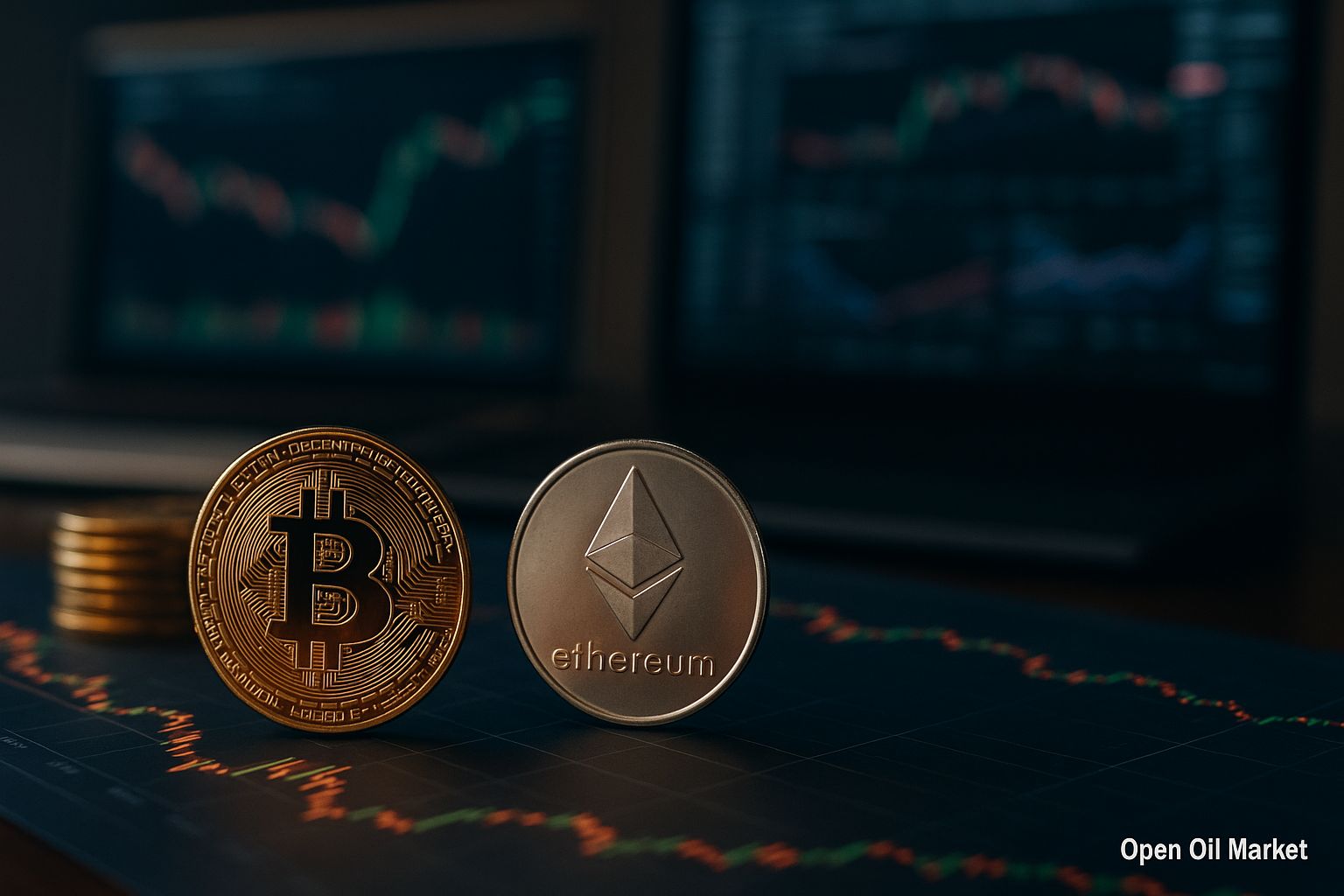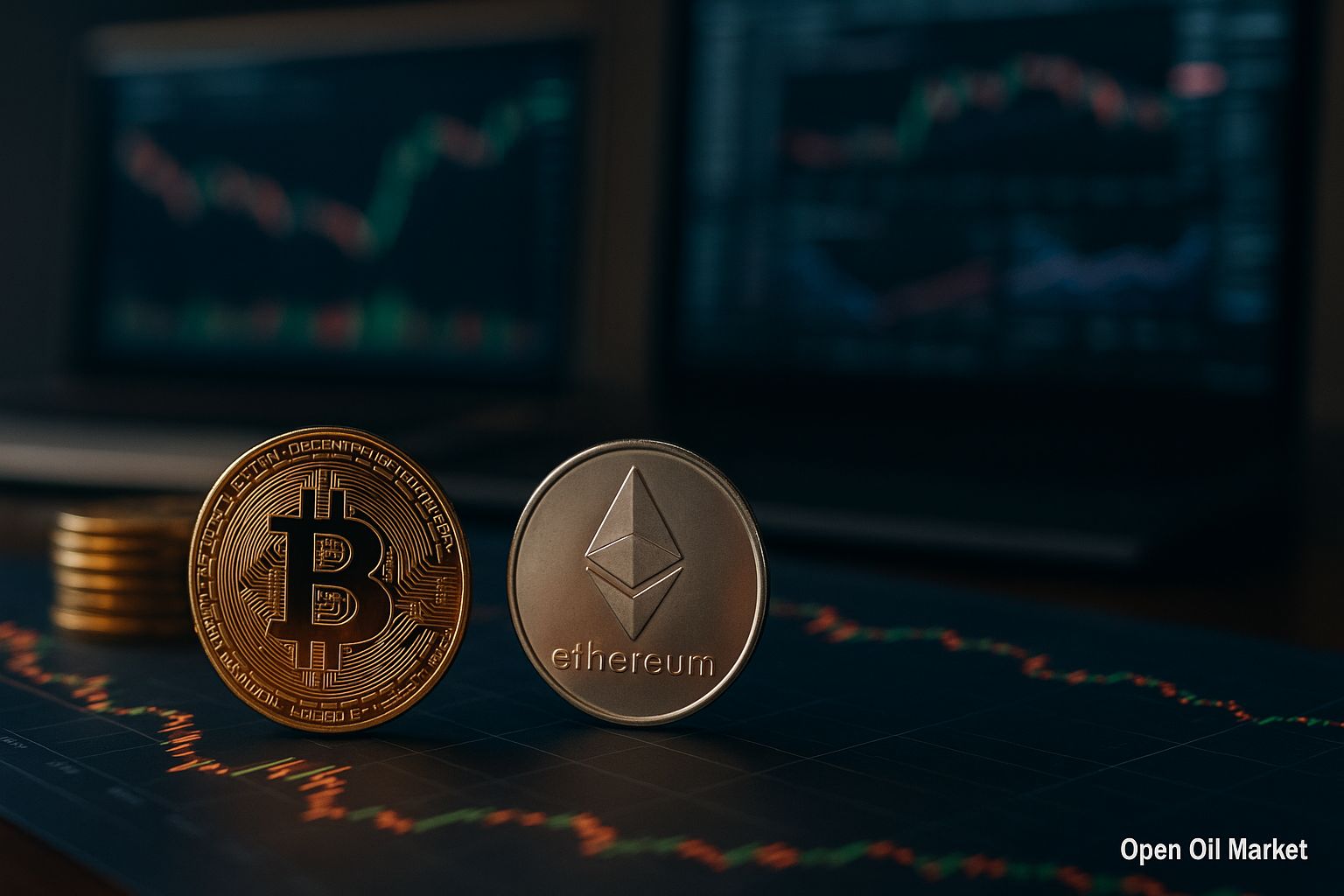
Cryptocurrency Market Overview – August 7, 2025: Key Events, Institutional Investments, Regulations in the USA and Hong Kong, and Dynamics of the Top 10 Cryptocurrencies.
The cryptocurrency market exhibits a relative calm after a recent surge, entering a phase of consolidation. Investors are balancing caution and optimism amid improved regulatory clarity and deepening participation from major players. The focus is on the stable positions of Bitcoin and Ethereum, new moves from institutional investors (ETFs, corporate investments), and ongoing regulatory changes shaping the market landscape as of August 7, 2025.
Crypto Market: Waiting for the Next Impulse
Following a rapid rally in recent months, the cryptocurrency market has transitioned into a state of relative stability. Bitcoin and most altcoins are holding close to recent highs, despite periodic profit-taking. The total market capitalization of digital assets, having surpassed the significant milestone of several trillion dollars in July, is currently oscillating without sharp fluctuations. Partial profit-taking following impressive growth is seen as a healthy correction – such consolidation lays the groundwork for a potential new upward move.
External macroeconomic factors continue to influence investor sentiment. Global markets are maintaining caution due to geopolitical uncertainty and anticipating new signals from the US Federal Reserve concerning monetary policy. The absence of negative surprises – for example, the Fed’s base rate remained unchanged at the latest meeting – supports interest in risk assets. Furthermore, the unexpected vote by two Fed board members in favor of a rate cut (the first time in decades) has heightened hopes for a policy easing as early as this fall. Upcoming releases of fresh inflation data and the annual Fed symposium in Jackson Hole may increase volatility. In the meantime, the cryptocurrency market demonstrates rare stability, indicating maturing dynamics and the growing role of institutional capital in price support.
Bitcoin: Holding Positions Amid Market Caution
The first cryptocurrency continues to consolidate near its recent peak values. In July, Bitcoin set a historical maximum near $123,000 and subsequently settled into a narrow range around the mid-$110,000 level. Short-term traders capitalized on the surge to sell around the psychological barrier of $120,000; however, long positions in BTC remain intact. The blockchain has witnessed activity from major holders (“whales”), who partially took profits at the peaks, while institutional investors and crypto funds are concurrently accumulating coins.
Experts note that Bitcoin's limited supply and capital influx from companies and funds foster a sustainable bullish sentiment in the long term. A number of Wall Street analysts predict that under favorable macro conditions, BTC could achieve new record highs by the year-end. In the short term, fluctuations are not ruled out: the current pause provides the market with a breather before a potential next upswing. It's crucial for investors to maintain balance: despite Bitcoin's confident position, the risk of short-term pullbacks persists.
At the same time, some indicators show heightened caution in the market. There has been a surge in demand for protective put options in crypto, with strikes around $95,000–$100,000, suggesting that some traders are hedging against a drop in BTC below the psychological level of $100,000 by month-end. Additionally, earlier this week, around $200 million was withdrawn from American Bitcoin ETFs over a few days amid economic concerns. However, these precautionary measures haven’t triggered a catastrophic price drop—demand for BTC remains robust enough to absorb selling. This underscores a solid foundation of investor interest: even amidst risk hedging and partial profit-taking, Bitcoin remains stable within a defined corridor.
Ethereum: Investor Interest and Staking Benefits
Ethereum (ETH), the second-largest cryptocurrency by market capitalization, is trading near recent maximums after a remarkable climb. Last month, Ether broke the $3,500 barrier for the first time since spring, approaching the psychologically significant mark of $4,000. While it was unable to breach the $4,000 level immediately due to profit-taking from some holders, fundamental trends for Ethereum remain positive. Institutional investors are increasing their presence: ETH-focused ETFs have recorded capital inflows each week for the past months, reflecting high interest in this asset.
One key factor driving Ethereum's attractiveness for major players is the ability to earn yield through staking. Unlike Bitcoin, which generates returns solely from price appreciation, ETH allows holders to participate in transaction validation and earn rewards on the order of 3–5% annually. This combination of growth potential and passive income positions Ethereum as the “digital oil” of the crypto industry—an essential asset on which decentralized finance (DeFi), NFT marketplaces, and many blockchain services are built. This status supports corporate interest: recent estimates show that the combined reserves of ETH on the balance sheets of public companies reached about 1 million coins by the end of July. Despite inherent volatility, many investors view Ethereum as a technological platform with significant long-term growth potential.
XRP: Multi-Year Highs and New Benchmarks
Ripple’s token XRP continues to hold a leading position in the market, recently rising to price levels unseen since late 2018. This increase was made possible by significant legal victories for Ripple: a US court previously confirmed that secondary sales of XRP are not securities, removing a substantial portion of regulatory risk from the asset. Though the final resolution in the protracted dispute with the SEC has not yet been reached (the regulator's formal appeal still stands), market sentiments are bullish. If the SEC officially withdraws its claims in the coming weeks, years of uncertainty regarding XRP's status will fade away.
Additional momentum for XRP may come from new investment products. The recent loosening of the SEC's stance has opened the door to the launch of ETFs for several major altcoins, including XRP, assuming relevant futures contracts are established. Analysts believe that the market could see the first such products in the fall, provided regulators grant final approval. Consequently, XRP finds itself at a turning point: established legal clarity and the launch of ETFs could drive a new growth phase for the token, while delays in decisions may dampen enthusiasm among some investors. Nevertheless, institutional interest in XRP remains strong—large players view it as a promising asset for diversification, given Ripple's successful development in the cross-border payment space.
XRP’s recognition is also expanding internationally. In Japan, financial conglomerate SBI Holdings has announced plans to apply for an ETF that would uniquely combine exposure to two cryptocurrencies—Bitcoin and XRP. If approved, this fund would be the first of its kind and highlight XRP’s growing acceptance as a legitimate instrument in regulated markets. Such a step could attract additional institutional capital to the token and increase trust from conservative investors.
Other Leading Altcoins: Mixed Dynamics
The altcoin market is displaying divergent movement: some projects are rising on positive news, while others are temporarily stagnating. In the top 10 by market capitalization, besides BTC, ETH, and XRP, several popular cryptocurrencies are included:
- Binance Coin (BNB): The proprietary token of the largest crypto exchange Binance maintains a strong market capitalization position. BNB demonstrates stability amid a generally cautious market, although the Binance ecosystem is under close regulatory scrutiny. The BNB coin is widely used for transaction fee payments and in DeFi projects on Binance Smart Chain, which sustains demand for it.
- Cardano (ADA): The smart contract platform, developed based on a scientific approach, shows moderate dynamics. ADA remains in the top ten due to a stable community and regular network updates (recent upgrades enhance scalability and blockchain functionality). Investors view Cardano as a long-term project, although short-term price volatility remains.
- Solana (SOL): The high-speed blockchain, having endured significant challenges in 2022–2023, has managed to regain the trust of some investors. SOL is among the largest altcoins, with its technology attracting the attention of traditional businesses—Visa, for instance, has added Solana to its list of supported networks for stablecoin payments. It is anticipated that Solana may receive an additional capital influx if relevant crypto ETFs are approved in the USA.
- Dogecoin (DOGE): The most well-known meme cryptocurrency continues to hold a place in the top ten, although its price has been relatively stable of late. The movement of DOGE's price is still largely driven by community sentiment and media mentions. The inflationary model of issuance restrains long-term value growth, but the coin remains popular as a “gateway” asset for newcomers and a subject of speculation during news spikes.
- Tron (TRX): The blockchain platform focused on the entertainment industry and decentralized applications has strengthened its position and entered the list of the top coins. This has largely been a result of the active expansion of the Tron stablecoin protocol and the development of DeFi products on its platform. Recently, the Tron Foundation hinted at plans to raise up to $1 billion for the repurchase of additional TRX tokens into corporate reserves—this move reflects the confidence of the founders in the long-term value of their asset and is designed to bolster price stability.
Regulation: New Rules in the USA, Hong Kong, and the EU
Recent weeks have been marked by groundbreaking regulatory changes in cryptocurrencies across key global markets:
- USA: For the first time at the federal level, a law regulating digital assets comprehensively has been passed. President Donald Trump signed the **GENIUS Act**, establishing clear requirements for the issuance and backing of stablecoins (coins pegged to fiat currencies such as Tether (USDT) or USD Coin (USDC)). This law lays the foundation for a stablecoins market valued at about ~$250 billion, requiring issuers to maintain full reserve backing and high transparency. Concurrently, the SEC has launched “**Project Crypto**” – a reform package aimed at adapting financial rules for crypto assets. The regulator is easing its stance: it has been stated that most cryptocurrencies will not be considered securities, while new projects (ICOs, airdrops, etc.) will be afforded “safe harbors” — temporary regimes facilitating launches. Moreover, trading of spot crypto assets on regulated exchanges has been allowed alongside futures in collaboration with the Commodity Futures Trading Commission (CFTC). All these steps signal a more lenient attitude in the USA towards the industry and an aim to bring crypto trading back from offshore jurisdictions into the legal realm of America.
- Hong Kong: As of August 1, a law on stablecoins has come into effect, introducing a licensing system for stablecoin issuers under the supervision of the Hong Kong Monetary Authority (HKMA). Companies issuing stablecoins are now required to comply with strict requirements—from 100% backing of issued tokens to regular financial reporting to the regulator. Hong Kong is actively positioning itself as Asia's crypto hub, offering clear rules for business while simultaneously protecting investor rights. The new regulatory framework aims to attract crypto companies looking to operate legally in the region.
- European Union: The EU is continuing the phased implementation of the **MiCA** (Markets in Crypto-Assets) regulation, which establishes uniform rules for the circulation of crypto assets and stablecoins across eurozone countries. MiCA introduces registration and transparency requirements for crypto service providers, including consumer protection measures and anti-money laundering efforts. The EU seeks to ensure a balance between innovation and risk control, allowing cryptocurrencies to integrate organically into the financial system. The first licenses under MiCA are expected in 2024, but it is already evident that the European market is moving towards greater transparency and legitimacy of the industry.
Traditional Finance: Betting on Cryptocurrencies
- Visa: The payment giant continues to expand its involvement in the crypto economy. Visa announced the integration of new stablecoins and blockchain networks into its global payment system. In particular, the company now supports transactions in the stablecoins **PayPal USD (PYUSD)** and **Global Dollar (USDG)**, and has added compatibility with the **Stellar** and **Avalanche** networks alongside previously integrated Ethereum and Solana. This positions Visa as a multi-currency and multi-chain payment infrastructure, allowing banks and fintech companies to settle in stablecoins quickly and with minimal costs. This move strengthens Visa's role as a bridge between traditional finance and the crypto world.
- PayPal: One of the largest payment platforms has launched a new service, **“Pay with Crypto,”** enabling tens of millions of merchants to accept payments in over 100 types of cryptocurrencies. Customers can now pay with Bitcoin, Ether, Litecoin, and other coins via linked wallets (including third-party ones like MetaMask or Coinbase Wallet), while sellers receive revenue in stable fiat currency. The crypto-to-fiat conversion occurs instantly using the stablecoin PYUSD from PayPal, minimizing volatility risks for businesses. Moreover, PayPal has set a reduced fee of 0.99% for such transactions (below typical banking card fees), aiming to encourage small and medium businesses to utilize crypto payments. This initiative simplifies international e-commerce and reduces costs, facilitating cryptocurrencies' entry into mainstream commercial circulation.
- Banking Sector: Following the passage of the relevant law in the USA, interest in stablecoins from traditional banks has surged. Several American banks are exploring options to issue their own digital dollars or implement blockchain solutions to expedite international payments. Concurrently, major asset management firms (such as BlackRock, Fidelity, etc.) continue to advocate for the launch of cryptocurrency exchange-traded funds, bringing the cryptocurrency market closer to the stock market. As a result, the boundaries between traditional finance and cryptocurrencies are gradually blurring: digital assets are no longer seen as a niche experiment, but are becoming part of the global financial ecosystem.
Crypto Industry: IPOs, Investments, and Corporate Strategies
- New IPOs: Cryptocurrency companies are going public. The exchange **Bullish** (the parent company of CoinDesk) has filed for an IPO in the USA, planning to raise up to $629 million with a valuation of around $4.2 billion. Major institutional investors, including BlackRock and ARK Invest, have already expressed readiness to purchase significant shares during the offering, indicating strong confidence in the future of the crypto business. Bullish's market debut will be one of the largest events for the industry since the Coinbase listing and underscores Wall Street's interest in cryptocurrency platforms.
- Challenges for Coinbase: The largest American cryptocurrency exchange is experiencing a cooling interest from investors amid declining trading volumes and revenues. Investment bank Compass Point recently downgraded Coinbase’s stock rating to "sell," citing a slowdown in user base growth and increased competition (including from decentralized platforms). Another challenge is the emergence of new stablecoins and DeFi services, drawing liquidity away from centralized exchanges. While Coinbase remains a key player in the market, this situation reveals that even industry leaders must adapt to the rapidly changing landscape.
- Corporate Reserves: An increasing number of public companies are incorporating crypto assets into their treasury reserves. In addition to investments in Bitcoin, a trend of accumulating Ethereum is gaining traction—recent reports indicate that companies collectively own billions of dollars in ETH, attracted by its functionality and yield from staking. At the same time, blockchain projects themselves are employing strategies to repurchase their own tokens: for instance, the leadership at Tron has announced plans to raise up to $1 billion for replenishing its treasury reserves of TRX tokens. This action is intended to support price stability and demonstrates the confidence of the founders in the long-term growth of their tokens' value.
- Outside the Industry: The strategy of accumulating cryptocurrencies is being adopted by companies from traditional sectors of the economy as well. This week several examples caught attention: an electronics manufacturer in the USA raised ~$500 million specifically to create a reserve in BNB tokens, while a pharmaceutical firm reported investing $110 million in Litecoin. These cases demonstrate that the integration of cryptocurrencies extends beyond the IT sector—players from various industries see digital assets as a strategic reserve. Such moves further legitimize cryptocurrencies in the eyes of the general public and create additional long-term demand in the market.
- Alternative Coins: Besides top market players, smaller projects are attracting capital amid favorable news. In recent days, there have been sharp price jumps for certain mid-cap altcoins: for example, a token from a blockchain project nearly tripled in price after migrating to a new level-Base network, while another coin gained over 60% due to a listing on a major exchange. Although such movements are localized, they indicate a continued appetite for risk among some investors and the market’s readiness to react strongly to technological innovations.
Market Outlook: Investor Expectations
The beginning of August brought a relative lull to the crypto market; however, a series of factors capable of charting a new trend lie ahead. Analysts agree that the current pause is technical: profit-taking after growth has allowed the market to cool, and such a breather typically precedes the next phase of growth. If the global economy provides positive signals—such as a continued slowdown in inflation and the largest central banks easing their rhetoric—investors may actively return to risk assets, including cryptocurrencies.
Industry events will also play a key role. A potential final resolution regarding XRP, the launch of the first ETFs for major altcoins (Solana, XRP, etc.), and the long-anticipated approval of spot Bitcoin ETFs in the USA—all of these, alongside the realization of announced institutional projects (new crypto funds, integration of stablecoins by banks), could significantly bolster confidence in the market. With favorable developments, experts do not rule out that by the end of 2025, Bitcoin and several leading altcoins may break historical highs once again, reaffirming cryptocurrency’s status as one of the most dynamic and attractive fields for investments.
In the meantime, many investors are adopting a wait-and-see strategy. The market is consolidating, but the fundamental prerequisites for new growth remain intact, making digital assets a vital part of a diversified investment portfolio even amid temporary stagnation.




